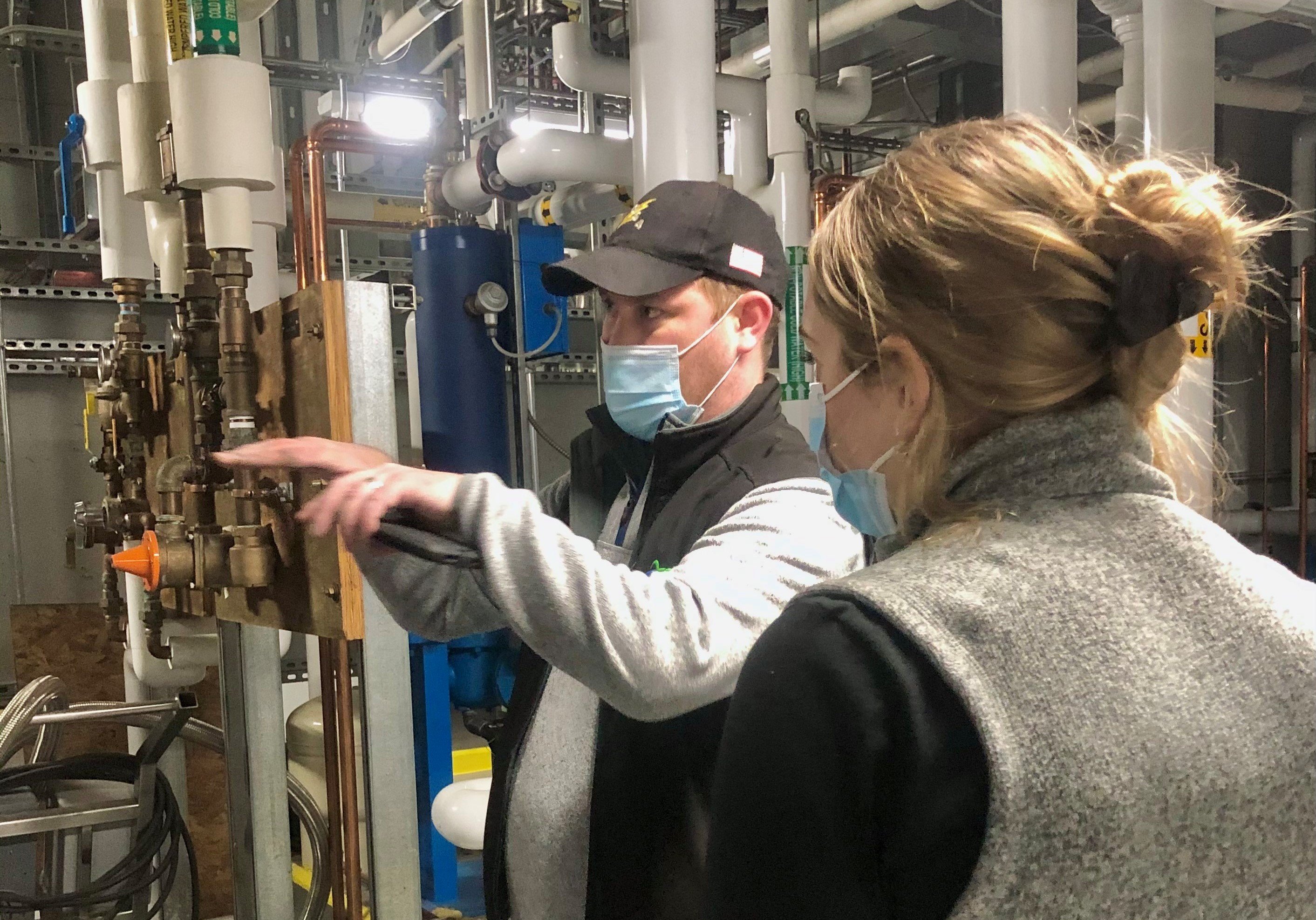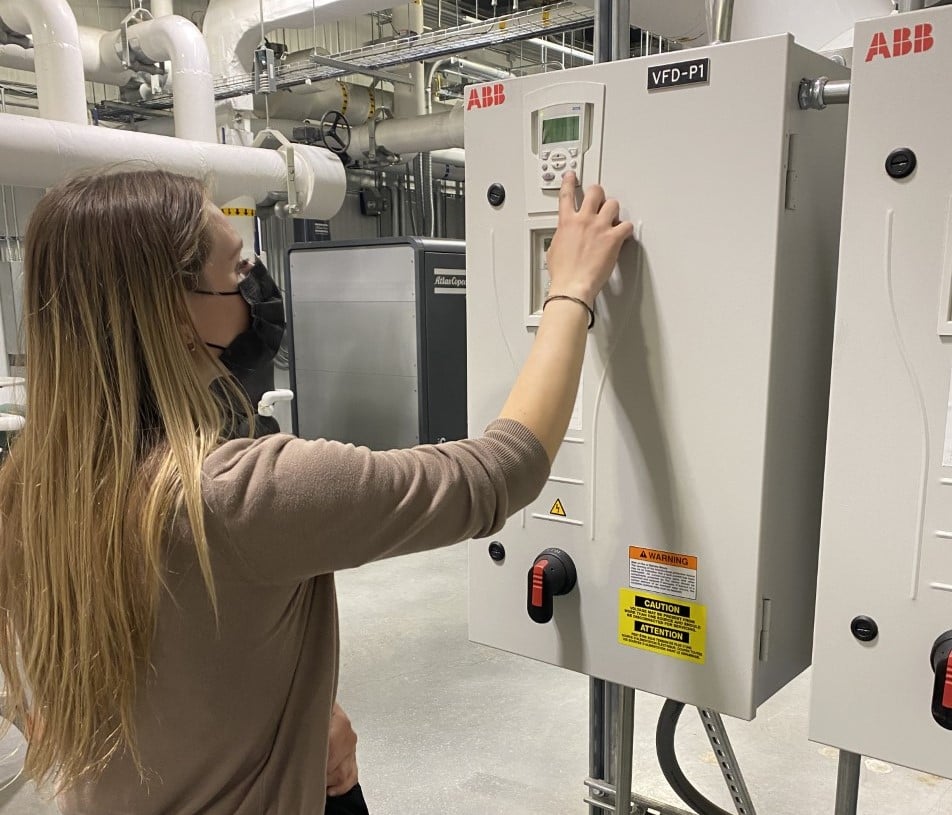Energy Efficiency | June 24, 2021
6 Months in Energy Efficiency: A Co-Op Reflection
What drew me into Mantis Efficiency Solutions were the efficiency solutions offered for a variety of industries. As a mechanical engineering student from Northeastern University, I have always been interested in the intersection of energy and engineering. As companies across the country pledge to reduce energy consumption and environmental impact, I was delighted to have the opportunity to work with a company that provides custom engineered solutions and turnkey project management.
During my time at Mantis I have worked on projects that have solidified my technical engineering skills while also being exposed to the business operations of the company firsthand. I learned a lot working with the experienced engineers and project managers, as they were incredibly knowledgeable about their work and took the time to teach as well, taking me alongside them on project sites consisting of a vast range of industrial and commercial buildings.
A hands-on approach to learning
The Efficiency Solutions division at Mantis takes a turnkey solutions approach. I learned that for our clients, this means they can trust us to engineer, manage and build their solutions. For me – an engineering co-op – it meant I was able to take part in every step of a project from start to finish.
With each project I worked on, I was able to exercise and improve on the skills I entered with as an engineering student. This was extremely beneficial as what I had learned previously in my classroom experience was very different from what I was able to learn through the hands-on experience at Mantis.
For example, my supervisor, Director of Project Manager, Tom Cashman, entrusted me with a multitude of projects throughout the duration of my time at Mantis. I’m grateful for my mentorship under him as he was a great resource for my own personal learning and growth as an engineer. Senior Project Manager Jim Taxiera, would thoroughly explain how energy efficiency was involved in each piece of equipment being installed, even taking the time to show me around machinery outside the scope of our projects.
I am especially appreciative of Peter Fairbanks, Chief Executive Engineer, who every Friday would host mechanical sales meetings with the intention of discussing different existing HVAC systems one might find in the field and the unique efficiency solutions Mantis offers. These meetings gave me an opportunity to better deepen my understanding of the information I was absorbing on site.

Achieving the best results for our clients
Projects started off with initial calls with clients to find out their energy needs since our goal is to provide solutions catered to their specific requirements. As we are a full-service firm, I quickly learned how important it is to take a comprehensive approach in identifying efficiency opportunities. We prioritized the client’s need and provided the most cost-effective solutions possible. This required learning about incentives and consequentially about how beneficial they can be for the clients.
Utility costs take up a large percentage of an industrial and commercial building’s operational spend. Luckily, utility companies offer incentive programs to assist in the cost of energy efficient retrofits and installations that will in turn reduce the buildings’ energy load. Depending on the state, the incentive bonuses are high. I was able to work with our national accounts team to help obtain these incentives in multiple states, learning about the different rebates offered across the country.
Working on mechanical and lighting projects
Conducting energy audits in our clients’ buildings was a large part of the project process and allowed me to work directly with the project managers. On these audits I was able to see for myself where the client could benefit from our help. I then would take part in deciding retrofit options for maximum optimization, ordering equipment and finally commissioning fixtures.
I learned so much about the difference between mechanical and lighting turnkey projects. Being on-site for different projects allowed me to learn from and work with different members of our team. My involvement in the project processes for both the mechanical and lighting teams at Mantis enabled me to understand all sides of the comprehensive incentives offered by utilities.

Campus wide LED lighting project
A project that holds special value to me is a large scale, campus-wide lighting retrofit for a university in Connecticut. It was very big project and one that I was able to be on from the start of my Co-Op. Our goal was to reduce the energy load and corresponding maintenance cost of the university by implementing LED lighting in 20 of the buildings on campus. I was particularly drawn to this project because it required innovative and cutting-edge controls technology.
- Tier 1 lighting controls are manual lighting adjustments, this type usually consists of wall occupancy sensors or dimer switches
- Tier 2 lighting controls consist of involved wireless integrations to a device. This involves adding occupancy sensors as well as the ability for high-end trimming and light levels. Lighting systems with tier 2 controls can also group fixtures into zones which allow more efficiency with less egress traffic.
- Tier 3 lighting controls have all the benefits of tier 2 but it integrates the controls into a building management system. This creates the ability to tie in the building’s HVAC systems into the occupancy controls of lighting system.
Implementing modern tier 3 lighting controls system involved frequently being on-site and working directly with the manufacturer to ensure the proper materials would arrive in time for installation. On this project, I learned how to best optimize the controls for each unique space across campus to ensure the most efficient lighting results for the client.
Looking back on my experiences
As I close out my co-op at Mantis Innovation and find the time to reflect on the last six months, I can undoubtedly say I feel more experienced and confident in my engineering skills. Working here has given me the opportunity to work both independently and collaboratively with a variety of experts in the energy efficiency field. I am incredibly thankful for the opportunities that Mantis has given me to strengthen my technical engineering and professional skills in a nurturing work environment.
Related Posts
Discover more content and insights from Mantis Innovation

The Cost of Inaction: Why Businesses Should Act Now on Energy Efficiency
In today's fast-paced business environment, the financial and operational losses businesses incur by delaying energy efficiency improvements, the "cost of inaction," is more relevant than ever.

In today’s AI era, human intelligence is the key to data center facility and energy optimization
Nowhere else in modern industry do artificial and human intelligence converge with such transformative potential as in the world of data centers. As AI's extraordinary growth accelerates demand for

Your Guide to LED Lighting for Business and Commercial Buildings
Never to be underestimated, LED lighting and well-designed lighting retrofits and upgrades offer businesses big improvements like reduced energy costs, reduced emissions, and improved working

Five Trends Driving Data Center Facility Energy Optimization
Today’s digital economy, commercial and industrial digitalization, and the recent explosion in artificial intelligence and machine learning (AI/ML) powered computing are driving massive growth in
